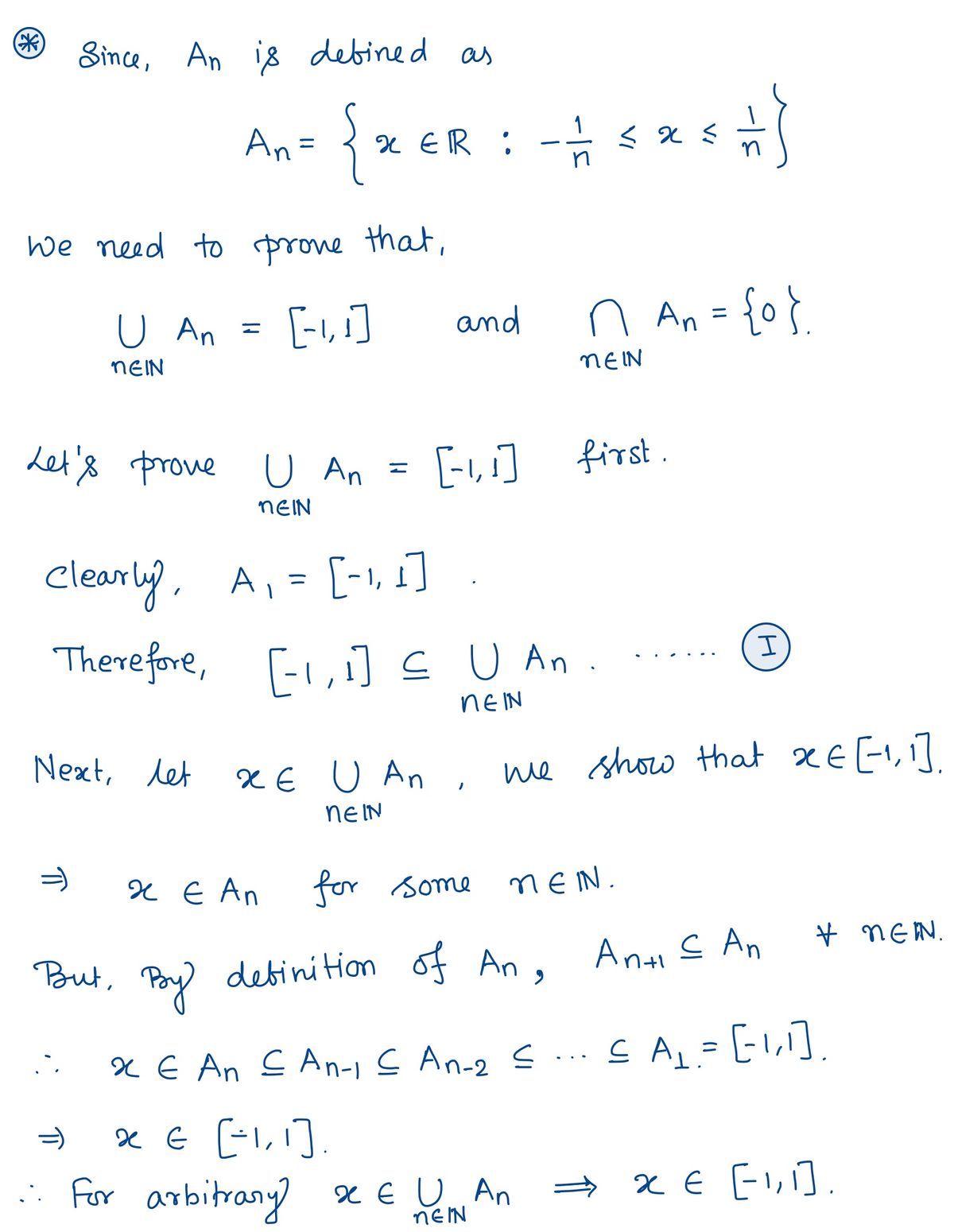For each n = N, define A, to be the closed interval [-] of real numbers; that is, 1 4=|T6R: +3+3|| An XER: ≤x≤ n n So A₁ = [−1, 1], A₂ = [−½, ½], A3 = [− }, }] and so on. We have now defined the sets A₁, A2, A3, … ... The union of these sets can be written as A₁ U A2 U A3 U ….. or Uº₁ A₁. Using N as an index set, we can also write this union as Unen An. Since Añ C A₁ = [−1, 1] for every n € N, it follows that Unen An = [−1, 1]. Certainly, 0 € An for every n = N; in fact, nen An = {0}.
For each n = N, define A, to be the closed interval [-] of real numbers; that is, 1 4=|T6R: +3+3|| An XER: ≤x≤ n n So A₁ = [−1, 1], A₂ = [−½, ½], A3 = [− }, }] and so on. We have now defined the sets A₁, A2, A3, … ... The union of these sets can be written as A₁ U A2 U A3 U ….. or Uº₁ A₁. Using N as an index set, we can also write this union as Unen An. Since Añ C A₁ = [−1, 1] for every n € N, it follows that Unen An = [−1, 1]. Certainly, 0 € An for every n = N; in fact, nen An = {0}.
Advanced Engineering Mathematics
10th Edition
ISBN:9780470458365
Author:Erwin Kreyszig
Publisher:Erwin Kreyszig
Chapter2: Second-order Linear Odes
Section: Chapter Questions
Problem 1RQ
Related questions
Question
Is it possible to explain the following proof example more in steps, and a bit simpler?
![For each n € N, define An to be the closed interval [-
n
1
A-[IER: - SXS ||
An
=
n
of real numbers; that is,
So A₁ = [-1, 1], A₂ = [− ½, ½ ], A3 = [− ½, 3] and so on. We have now defined the sets
A₁, A2, A3, .... The union of these sets can be written as A₁ U A₂ U A3 U... or U₁₁ Ai.
Using N as an index set, we can also write this union as Unen An. Since An CA₁ =
[−1, 1] for every n € N, it follows that Unen An = [−1, 1]. Certainly, 0 € A, for every
n = N; in fact, ÊN A₂ = {0}.
=](/v2/_next/image?url=https%3A%2F%2Fcontent.bartleby.com%2Fqna-images%2Fquestion%2F8e237d3f-b8e6-4775-a6f9-5671b153aef2%2Ffe8255d2-1e51-4854-8cdb-ceee6c06a87d%2Fkol9w7_processed.png&w=3840&q=75)
Transcribed Image Text:For each n € N, define An to be the closed interval [-
n
1
A-[IER: - SXS ||
An
=
n
of real numbers; that is,
So A₁ = [-1, 1], A₂ = [− ½, ½ ], A3 = [− ½, 3] and so on. We have now defined the sets
A₁, A2, A3, .... The union of these sets can be written as A₁ U A₂ U A3 U... or U₁₁ Ai.
Using N as an index set, we can also write this union as Unen An. Since An CA₁ =
[−1, 1] for every n € N, it follows that Unen An = [−1, 1]. Certainly, 0 € A, for every
n = N; in fact, ÊN A₂ = {0}.
=
Expert Solution
Step 1: Explanation of proof

Step by step
Solved in 4 steps with 3 images

Recommended textbooks for you

Advanced Engineering Mathematics
Advanced Math
ISBN:
9780470458365
Author:
Erwin Kreyszig
Publisher:
Wiley, John & Sons, Incorporated

Numerical Methods for Engineers
Advanced Math
ISBN:
9780073397924
Author:
Steven C. Chapra Dr., Raymond P. Canale
Publisher:
McGraw-Hill Education

Introductory Mathematics for Engineering Applicat…
Advanced Math
ISBN:
9781118141809
Author:
Nathan Klingbeil
Publisher:
WILEY

Advanced Engineering Mathematics
Advanced Math
ISBN:
9780470458365
Author:
Erwin Kreyszig
Publisher:
Wiley, John & Sons, Incorporated

Numerical Methods for Engineers
Advanced Math
ISBN:
9780073397924
Author:
Steven C. Chapra Dr., Raymond P. Canale
Publisher:
McGraw-Hill Education

Introductory Mathematics for Engineering Applicat…
Advanced Math
ISBN:
9781118141809
Author:
Nathan Klingbeil
Publisher:
WILEY

Mathematics For Machine Technology
Advanced Math
ISBN:
9781337798310
Author:
Peterson, John.
Publisher:
Cengage Learning,

